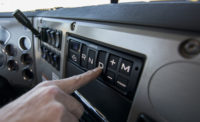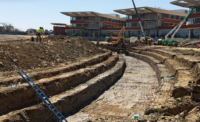As the general public is exposed almost daily to marketing that promotes the prospects of self-driving cars, it’s not too much of a stretch for construction professionals to imagine a similar future for autonomous equipment on the jobsite. But it won’t happen quickly, say industry leaders.
“Fully autonomous construction is not yet here,” says Jason Anetsberger, senior product manager for Komatsu America’s intelligent machine-control product line. “Now, if you’re talking about what is autonomous to construction at this moment in time, it’s really about adding technology and automation into the machines to improve their accuracy and production and to make that operator capable of getting more productivity out of the machine. The limited automation we have today is still more than ever before. We’re going to see that keep increasing over time—I think that trend is clear—but fully autonomous does not yet exist.”
In terms of equipment, the general construction market’s big brother is the mining industry. In that world, excavators are transformed into giant shovels, and the trucks they load are true hauling behemoths. The fact that fully autonomous hauling fleets are in operation at select mines in leading markets—such as Australia and the U.S., specifically in the West—might prove tempting to fleet managers of construction firms working on, for example, urban development sites.
“There is no immediate future for that vision because there are just too many things going on at a construction work site,” says Raleigh Floyd, branding and communication manager at Komatsu America. “Now, can we get there? How quickly will the marketplace want and be prepared to adopt this? We’re going to follow their lead in that respect, and if that’s where it takes us, then so be it. But it will be as a result of meeting market demand.”
Article Index:
Already There
So, what are leading mining operations already doing that has some aboveground contractors interested? Leading original equipment manufacturers such as Komatsu and Caterpillar have developed technologies that allow the largest, most productive and, at times, most at-risk equipment types and models to be operated from a safe distance.
As part of the MineStar system, Caterpillar currently offers three different autonomous or semi-autonomous machine types.
Fully autonomous mining truck fleets are operating at iron-ore mines in western Australia, led by Fortescue Metals Group’s 45-piece team of 250-ton 793F trucks. Using a Cat product called Command for Hauling, the largest autonomous fleet operating at a single mining complex already has hauled more than 110 million tons. The Command suite of products, which also extends to Command for underground, dozing, drilling and long-wall applications, gathers and processes data from all MineStar capability sets. The integration of machine data, tracking and management provides remote-based operators with a broad view of operations but also with the ability to zoom in on individual machines and specific groups of equipment to make autonomous operations safe within the context of other mine activities.
At the same time, semi-autonomous D11T track-type tractors are in operation via Command for Dozing at Arch Coal’s Black Thunder Mine in Wyoming. A single operator, seated in a remote location, is able to control four of the large dozers by setting up each one in a “push” and then monitoring the autonomous completion of the task. This installation has been in trial mode for about two years, and additional sales are anticipated, particularly in Australia.
In locations around the world, notably now in Nevada and soon in Ontario, semi-autonomous Caterpillar underground loaders are overcoming the inherent hazards of the underground mining environment. Using Command for Underground, the load-haul-dump machines autonomously carry out the travel and dump phases of their work cycles. The operator, located in a spot clear of the operating zone, uses tele-remote control to load the bucket at the mining face. The automated system allows faster travel speeds and reduces to “near zero” the common damage caused by machines running into walls, reports John Carpenter, Caterpillar’s manager of global technology and solutions.
Each of the three categories of autonomous and semi-autonomous machines continue to be refined, while efforts move ahead to automate fully other mining machines, Carpenter notes. Coming to the market next will be rotary blast-hole drills, the company anticipates.
At the world’s largest construction-industry trade show—Bauma 2016, held in April in Munich—Caterpillar publicly declared its intent “to create a digital business, if you will,” said Carpenter. “[But we will not be] steering from our traditional heritage of creating world-class machines and engines and offering world-class product support but also offering an ability for digital insights and digital solutions that complement our traditional business.”
Combining Technologies
Not unlike what Caterpillar has done with its underground mining loaders, Komatsu recently has taken an aboveground earthmover suited for North American site-prep applications and “removed the operator while keeping the productivity.” The concept of radio control, as employed on the new 12.3-cu-yd D155AXi-8 RC dozer, is not new; what sets the new model apart is its integration of radio control with intelligent machine control, the latter of which now is offered on six Komatsu dozer sizes, including a second-generation D61EXi/PXi-24 version of the introductory 5-cu-yd model.
“In the past, there has been radio control,” says Anetsberger, who this past May introduced the D155AXi-8 RC at a customer and dealer event in Cartersville, Ga. “But it was still 100% manual operation, and, therefore, it was very difficult to get good production out of the machine. The operator was removed from all the sensations, the vibrations [and] the feelings about being in the machine and knowing how it’s performing. By automating the work equipment, we minimized any production loss by removing that operator from the machine.”
With intelligent machine control on dozers, a GNSS antenna and receiver track multiple satellite signals that, in turn, allow the base station, set to a known point on the jobsite, to broadcast correction information to the machine. The current position of the blade is compared to the project’s 3D model, and an automatic hydraulic interface can accurately move the blade to the exact design grade.
When unveiled to customers this spring at the Georgia event, the D155AXi-8 RC had skeptics, says Sebastian Witkowski, product marketing manager, intelligent machine-control product. Past experiences with radio or remote control were justifiably behind the suspicions of equipment owners and operators, says Witkowski, who monitored the new machine’s operation at the event. “After running a pass or two down the field, they remarked that it’s really easy to pick up and, most critically, how difficult it would be to operate without the intelligent machine control incorporated into the machine,” he says.
Since its debut with dozers, the intelligent machine-control product family has expanded into the excavator product line, initially with the lighter-weight PC210LCi-10, a 21-metric-ton machine with automated 3D GNSS capabilities. This spring, that “straight-to-grade” product line grew into the heart of the North American construction market with the 36-metric-ton PC360LCi-11 and 49-metric-ton PC490LCi-11 models. “That frees the operator up to think about the overall jobsite and what he’s trying to accomplish without having to be so focused on minute movements of the blade,” says Anetsberger. “Where we’re doing right now is to make individual operators more efficient. That’s really the focus of the technology today.
“We’re trying to get the most out of that man or woman inside that machine or tied to a particular piece of equipment,” says Anetsberger. “I think there is always going to be a spot for that man or woman there on the jobsite.”
Calling Operators
The industrywide demand for operators will not disappear and nor will individual opportunities for operators, predicts Caterpillar’s Carpenter, whose 2015 “Jobsite of the Future” presentation helped the industry to envision a much different construction site than it has long been used to. “We strongly believe that certain types of projects and certain types of equipment are going to lend themselves to full autonomy—in other words, unmanned movement of that equipment,” says Carpenter. “But I went on to say—and I still believe—that for that to happen overnight on all pieces in all applications isn’t going to make sense.
“What I do see is massive improvements in job-site efficiencies and productivity. What I don’t see is a big drop in the need for operators,” Carpenter says. “I see, if anything, maybe a drop in the amount of equipment that’s needed in the future.” In other words, there will be more intelligence, less iron.
Carpenter says the jobsite “will change quite a bit as far as the ease and flow of information or predictive insights that go to a customer’s mobile device or on their wristwatch or whatever it is in the future that is pushing answers to questions we haven’t even thought about asking.”
|









Post a comment to this article
Report Abusive Comment